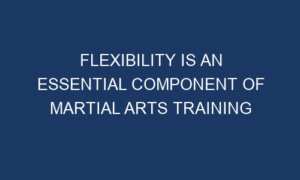Flexibility is an essential component of martial arts training. It allows practitioners to perform techniques with greater ease, power, and efficiency. In addition, flexibility training can provide a range of physical and mental benefits that can enhance overall health and well-being. In this post, we will explore the importance of flexibility in martial arts and the different ways in which martial arts practitioners can improve their flexibility.
Benefits of Flexibility in Martial Arts Improved range of motion: Greater flexibility allows for a wider range of motion in joints and muscles. This can enable martial arts practitioners to perform techniques that require greater mobility and agility.
Enhanced athletic performance: Flexibility training can improve athletic performance by increasing the efficiency and effectiveness of movements. This can lead to greater speed, power, and accuracy in martial arts techniques.
Reduced risk of injury: Flexibility training can help reduce the risk of injury by promoting better muscle balance, joint mobility, and posture. This can reduce the likelihood of strains, sprains, and other common martial arts injuries.
Better posture and balance: Flexibility training can help improve posture and balance, which are important for maintaining proper body alignment and stability during martial arts techniques.
Increased relaxation and stress relief: Flexibility training can help promote relaxation and stress relief by reducing muscle tension and promoting deeper breathing.
Types of Stretching There are different types of stretching that can be used to improve flexibility:
Dynamic stretching involves movements that mimic the movements used in martial arts techniques. This type of stretching is often used as a warm-up before training.
Static stretching involves holding a stretch for a period of time, usually 20-30 seconds. This type of stretching is often used to improve overall flexibility.
PNF stretching (proprioceptive neuromuscular facilitation) involves a combination of stretching and contracting muscles. This type of stretching can be particularly effective in improving flexibility.
Techniques to Improve Flexibility There are several techniques that martial arts practitioners can use to improve their flexibility:
Regular stretching routines: Consistent stretching can help improve flexibility over time. Practitioners should aim to stretch all major muscle groups, including the hips, back, shoulders, and legs.
Partner stretching exercises: Partner stretching exercises can help increase the intensity and effectiveness of stretching. This can be particularly helpful for stretches that require greater resistance, such as hamstring stretches.
Yoga and Pilates: These practices can be helpful in improving flexibility, strength, and balance. Many martial arts schools offer yoga and Pilates classes as part of their training programs.
Foam rolling and self-massage: Foam rolling and self-massage can help release tension and improve flexibility in muscles and joints. This can be particularly helpful for areas that are prone to tightness, such as the calves, hamstrings, and IT band.
Importance of Flexibility in Different Martial Arts Styles Flexibility is important in all martial arts styles, but it may be emphasized differently depending on the style. For example:
- Karate: Karate practitioners often focus on hip flexibility to perform techniques such as kicks and strikes with greater power and speed.
- Taekwondo: Taekwondo practitioners often focus on leg flexibility to perform high kicks and acrobatic techniques.
- Brazilian Jiu-Jitsu: Brazilian Jiu-Jitsu practitioners often focus on flexibility in the hips and spine to perform techniques such as guard passes and submissions.
- Muay Thai: Muay Thai practitioners often focus on hip flexibility to perform powerful kicks and knee strikes.
Incorporating Flexibility Training in Martial Arts Practice Flexibility training should be incorporated into all martial arts training programs. Practitioners can improve their flexibility by:
- Including pre-workout warm-ups and stretching exercises to prepare the body for training.
- Including post-work
out stretching exercises to cool down and promote muscle recovery.
- Designing specific flexibility training routines that target areas of the body that are important for their particular martial arts style.
- Seeking guidance from a qualified martial arts instructor or personal trainer to design an effective flexibility training program.
In conclusion, flexibility is an essential component of martial arts training. It provides a range of physical and mental benefits that can enhance overall health and well-being. Martial arts practitioners can improve their flexibility through regular stretching routines, partner stretching exercises, yoga and Pilates, foam rolling and self-massage, and specific flexibility training programs. By incorporating flexibility training into their martial arts practice, practitioners can improve their athletic performance, reduce the risk of injury, and enhance their overall martial arts experience.

